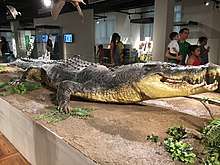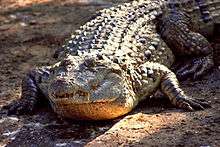Philippine crocodile
The Philippine crocodile (Crocodylus mindorensis), also known as the Mindoro crocodile, the Philippine freshwater crocodile, the bukarot[2] in Ilocano, and more generally as a buwaya in most Filipino lowland cultures,[2] is one of two species of crocodiles found in the Philippines; the other is the larger saltwater crocodile (Crocodylus porosus).[3][4] The Philippine crocodile, the species endemic only to the country, became data deficient to critically endangered in 2008 from exploitation and unsustainable fishing methods,[5] such as dynamite fishing.[6] Conservation methods are being taken by the Dutch/Filipino Mabuwaya foundation,[7] the Crocodile Conservation Society and the Zoological Institute of HerpaWorld in Mindoro island. It is strictly prohibited to kill a crocodile in the country, and it is punishable by law.

| Philippine crocodile | |
|---|---|
 | |
| An adult basking on the island of Palawan, Philippines | |
| Scientific classification | |
| Kingdom: | Animalia |
| Phylum: | Chordata |
| Class: | Reptilia |
| Order: | Crocodilia |
| Family: | Crocodylidae |
| Genus: | Crocodylus |
| Species: | C. mindorensis |
| Binomial name | |
| Crocodylus mindorensis Schmidt, 1935 | |
| Range of the Philippine crocodile in blue | |
Taxonomy and etymology
Until 1989, it was considered a subspecies of the New Guinea crocodile (Crocodylus novaeguineae).[8]
Characteristics
The Philippine crocodile is a crocodilian endemic to the Philippines. It is a relatively small, freshwater crocodile. It has a relatively broad snout and thick bony plates on its back (heavy dorsal armor). This is a fairly small species, reaching breeding maturity at 1.5 m (4.9 ft) and 15 kg (33 lb) in both sexes and a maximum size around 3.1 m (10 ft).[8] Females are slightly smaller than males. Philippine crocodiles are golden-brown in color, which darkens as they mature.
Distribution and habitat
The Philippine crocodile has been extirpated in Samar, Jolo, Negros, Masbate, and Busuanga. Populations still survive in the Northern Sierra Madre Natural Park within the Luzon rainforest, San Mariano, Isabela, Dalupiri island in the Babuyan Islands, Abra (province) in Luzon and the Ligawasan Marsh, Lake Sebu in South Cotabato, Pulangi River in Bukidnon, and possibly in the Agusan Marsh Wildlife Sanctuary in Mindanao.[8][9][10] It was historically found in parts of Visayas and until the numbers were drastically cut by, mainly, habitat destruction. These Crocodiles eat ailing fish in a significantly higher proportion than healthy fish, thus improving the common health of the fish stock. By preying on the most common fish, they balance the fish population; any species which suddenly becomes dominant is put back in its proper proportion. Crocodile droppings are nutritious for the fish and contain critically important chemicals.
Conservation status

Crocodylus mindorensis is considered to be the most severely threatened crocodile species in the world, listed as critically endangered by the IUCN. A population estimate of 100 non-hatchling individuals underlines the critical status of the species.[11] Although this species was once found over the whole of the Philippines, it is now critically endangered. In addition, very little is known about the natural history or ecology of the species, or its relationship with Crocodylus porosus, whose range it overlaps. More surveys are required to determine the present range. Initial population reduction was through commercial exploitation, although the current threat is mainly from removal of suitable habitat for agricultural purposes to satisfy a rapidly expanding human population. Governmental support for any conservation measures is limited, and the crocodiles are often killed by the local populace. This situation needs to be changed through awareness programs. Long-term captive breeding and release (through PWRCC, Silliman University, and international breeding centres) is judged to be the best course to take at present, although a management program is imperative for the remainder of the wild population (most of which reside in only one protected area). In 1992, fewer than 1000 animals were estimated to remain in the wild. In 1995, that estimate was revised to be no more than 100 nonhatchlings (hatchlings are rarely counted in surveys because their survival rate is so low). One of the threats to the diminishing population of Philippine crocodile is because it is misunderstood. In mainstream Filipino society, crocodiles are considered dangerous man-eaters and compared to corrupt government officials and law enforcers. They are respected by the indigenous community: in research conducted among permanent residents of Lake Panlabuhan, a tributary of the famous Agusan Marsh, the acceptance of the crocodiles among these residents is very high and their risk perception is very low. However, the crocodile have an image problem with outsiders. To many, they are viewed as man-eaters. In reality, the crocodile is small and will not attack people unless provoked.
The killing of crocodiles seems to be the major cause of the decreasing number of this species. In northeast Luzon, a community-based conservation approach developed under the Crocodile Rehabilitation Observance and Conservation (CROC) project was adopted with the aim of reaching sustainable co-habitation of crocodiles and local people.[11]

In 2007, a specialist group was founded by several people within the Philippines, involved in crocodilian conservation. The Crocodile Conservation Society Philippines and the Zoological Institute of HerpaWorld are working on conservation breeding and release programs. C. mindorensis was considered locally extinct in part of its former range in northern Luzon until a live specimen was caught in San Mariano, Isabela, in 1999. That individual, nicknamed 'Isabela' by its captors, was given to the care of the Crocodile Rehabilitation Observance and Conservation until it was released in August 2007. The specimen was 1.6 m long at the time of its release.[12]
The Philippine crocodile became nationally protected by law in 2001 with the enactment of Republic Act 9147 known as the Wildlife Act. It is punishable to kill a crocodile, with a maximum penalty of ₱100,000 (equivalent to about $2,500).[8] The Philippine Senate introduced resolution no. 790 on May 31, 2012, to further strengthen and augment existing laws for the protection of the Philippine crocodile and the saltwater crocodile.[13]
Media
This crocodile was featured in National Geographic's Dangerous Encounters hosted by crocodile specialist Dr. Brady Barr. In one of the episodes, Barr sought to be the first person to see all species of crocodiles in the world. Fortunately, he was able to see a Philippine crocodile that was about two weeks old.[14]
The hatching of a Philippine crocodile was recorded in GMA News Born to Be Wild. They also recorded that tropical fire ants, an invasive species, eat unhatched endangered bukarot eggs. The media team saved a nest from a fire ant attack. Also recorded were adult Philippine crocodiles.[15]
Mythology and folklore
The ancient Tagalog people believed that the soul of a deceased person is carried from the middle world into either Maca (place where good spirits go) or Kasanaan (place were evil spirits go) through the aid of a buwaya, a crocodile monster with lethargic skin and a tomb attached to its back, covered with its skin.[16] Although considered sacred, the buwayas are also feared as they may also attack living people, encasing them inside its tomb, and descend to the afterlife to bring the person to either Maca or Kasanaan, effectively bringing only the soul to the lands of the dead as the body has already died. Despite the extremes of the buwaya, it is so sacred to the ancient Tagalogs to the point that killing one (with a tomb or none) is punishable by death.[16]
See also
References
- van Weerd, M.; C. Pomaro, C.; de Leon, J.; Antolin, R. & Mercado, V. (2016). "Crocodylus mindorensis". IUCN Red List of Threatened Species. 2016: e.T5672A3048281. doi:10.2305/IUCN.UK.2016-3.RLTS.T5672A3048281.en.
- "Crocodile Surveys - iucncsg.org"
- "Only in the Philippines - Endemic Animals in the Philippines" Archived 2017-08-06 at the Wayback Machine. TxtMania.com. Retrieved on 2007-10-22.
- Ross, Charles A. "Crocodile Status in Ligawasan Marsh". Philippine Crocodile. Retrieved on 2012-07-12.
- "Crocodilian Species - Philippine Crocodile (Crocdylus mindorensis)". Crocodilian Species List. Retrieved on 2007-10-22.
- "Wildlife Conservation in the Philippines". BP.com. Retrieved on 2007-10-22.
- "Philippine Crocodile Comeback" Archived 2007-11-10 at the Wayback Machine. cepf.net. Retrieved on 2007-10-22.
- Van Weerd, Merlijn. "Philippine Crocodile (Crocodylus mindorensis)". Crocodile Specialist Group.
- "Info" (PDF). www.iucncsg.org. Retrieved 2020-01-02.
- "Manila Proceedings.indd" (PDF). Retrieved 2020-01-02.
- van Weerd, Merlijn; van der Ploeg, Jan (2004-01-01). "A new future for the Philippine crocodile, Crocodylus mindorensis". Sylvatrop. 13: 31–50.
- Burgonio, TJ (2007-08-25). "'Isabela,' the croc, to be freed in wilds". Breaking News: Regions. Inquirer.net. Archived from the original on 2007-09-02. Retrieved 2007-09-02.
- (2012-05-31). "Senate P.S.R. 790". Senate of the Philippines 15th Congress. Retrieved on 2012-07-16.
- National Geographic Channel Videos - Adventure Shows, Natural History & More channel. National Geographic. Retrieved on 2007-10-22.
- "Born to Be Wild: Actual hatching of a Philippine crocodile". YouTube. 2017-08-14. Retrieved 2020-01-02.
- "PHILIPPINES: The Monster Islands • THE ASWANG PROJECT". Aswangproject.com. Retrieved 2020-01-02.
Further reading
External links
- Mabuwaya Foundation [1]
- "Philippine crocodile" at the Encyclopedia of Life

- Weerd, Mabuwaya Foundation, Merlijn van. "Mabuwaya - Home". www.mabuwaya.org. Retrieved 2016-03-16.
